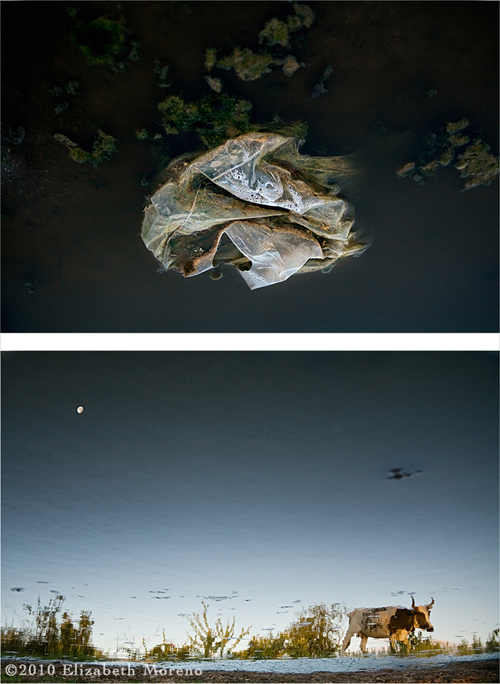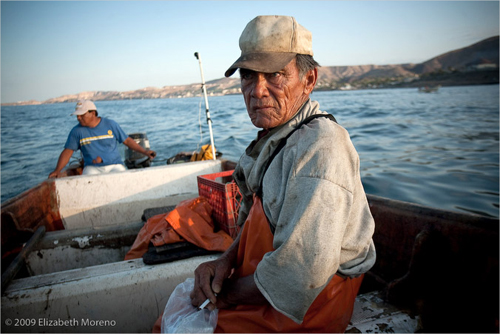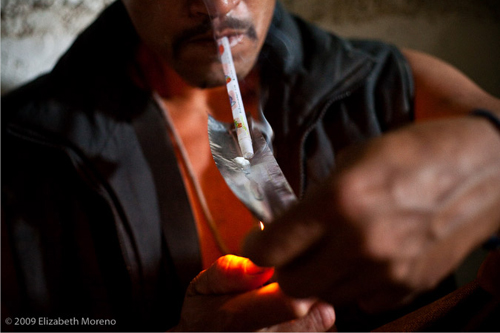After moving to the U.S. to study photography, Mexico-based photographer Elizabeth Moreno has spent the past two and a half years documenting her birthplace of La Paz, Baja California Sur. During that time, with help from a Jovenes Creadores 2009-2010 Grant (given by FONCA-CONACULTA), she has been able to document the daily life of the ranchero communities in the area. For her efforts toward this burgeoning project, which is titled “Lejos de las Urbes, Cerca de la Tierra,” Ms. Moreno was recently awarded the 2010 Daylight Magazine / CDS Work-in-Process Prize. She is continuing work on the project throughout the next year and will have an exhibition of the work in February in La Paz, Baja California Sur. This past week, Daylight caught up with Ms. Moreno to ask her some questions about the project as well as about her experiences working as a documentary photographer.
---
Interview by Trent Davis Bailey
Photographs by Elizabeth Moreno
Daylight: Could you explain your series, “Lejos de las Urbes, Cerca de la Tierra,” (“Far from the Cities, Close to the Earth”) as it relates to present-day social, economic, and environmental factors?
Elizabeth Moreno: With this series I am trying to portray a way of life that is rapidly changing and most likely coming to an end in the Peninsula of Baja California. As it has happened around the world since the industrial revolution, the countryside is being abandoned and its people absorbed by the urban environment. In this transition, a lot of their culture, traditions and knowledge are being lost.
Because of the isolation in which they live, the rancheros of Baja California have maintained the same lifestyle for almost 300 years. And now, for many reasons — such as bad remuneration for their work, a lack of sustainable development support by the government and/or NGOs, and the rancheros selling their land at very cheap prices — a lot of the younger generations are migrating to towns or cities.
Talking about environmental issues, I think that the rancheros, with a little support and direction from the government and NGOs, could be the best [facilitators] to take care of the peninsula’s fragile environment. But most of the time, because of deficient communication, urban people perceive the rancheros as predators and as a threat to the environment even though they have managed to be productive and live in this land for three centuries.

From the series, “Lejos de las Urbes, Cerca de la Tierra."
D: I’m interested in your use of the diptych as an aesthetic practice. More specifically, what inspired you to use diptychs for photojournalistic pursuits?
EM: I used diptychs in my previous project, “Huellas,” which paired untouched and transformed landscapes of Baja California Sur. Upon completion of “Huellas,” I wanted to take this way of photographing to a project that involved people. My current project (“Lejos de las Urbes, Cerca de la Tierra”) started with the idea to portray the rancheros within their environment. Working with diptychs allows me to put more emphasis on the little details I find in their surroundings. By using two contiguous images, I try to give more power to the images, show bits of information about their culture … and set [this information] side-by-side with each person I photograph. While I was working this way, I also started to photograph moments in their daily life. In this case, using a diptych allows me to play with time. It is the same event but each image is registered seconds, sometimes minutes apart. I find these instances more challenging to photograph because I have almost no time to scout the shot. It has to be identified and organized into two frames at the time that it is happening and you don’t know if it will work until you put the two images together. I find this way of shooting more exciting, even though I love doing the portrait part of the project too.

From the series, "Huellas."
D: When I first saw this series, I immediately thought of the multiple frame archetype of David Hilliard’s work; however, your photographs seem much more candid and less tableau. In these photographs, do you take directorial control of your subjects or are you just acting as witness to their lives?
EM: I do take directorial control in some of the portraits, but that is only related to the location (background) I want to make the portrait in. I don’t ask for a certain pose or attitude from the people I am photographing. Other times I find the person right where I want to photograph him or her and just do it with out having to ask them to move around. The diptychs that display moments of daily life are also spontaneous and I don’t take any kind of control on those shots.
D: At what point did you realize you wanted to become a photographer?
EM: I decided during my last semester of high school. I had been photographing (or learning to) for few years then and one of my tutors asked me what I would see myself doing in 10 or 20 years. I had many options and interests but I couldn’t see anything else but being a photographer.
D: How, if at all, does your cultural background influence your photographic ventures?
EM: I think the education I received and my cultural background definitely have shaped and continue to shape my career. I am curious about other people’s lives, their work, their traditions, their struggles and good times, and photography is a the way I can share this process with others who know nothing or very little about the themes and people I work with.
D: Regarding “the themes and people you work with,” you’ve photographed everything from gypsum mining to giant squid fishing to Alzheimer’s patients. How do you decide on and gravitate towards an idea or project? Is there a unifier to your photographic process and interests?
EM: For the past five years, I have mainly focused on themes that I have found in Baja California Sur, trying to depict what is currently happening in this isolated Mexican state. During the last two and a half years, all of my projects have happened because I am really interested in the themes, not because someone else has assigned them. Particularly, my last two projects, “Huellas” and “Lejos de las Urbes, Cerca de la Tierra,” started from a very deep interest in the environmental and social issues that exist in the peninsula’s countryside and coasts. Before starting stories somewhere else I have felt the necessity to document what is happening in the places I grew up in—and during a time that everything is changing really fast.


Both images from the series, "Giant Squid Fishing."
D: Given the level in which you embed yourself in your projects, there must be times when it is difficult to gain acceptance as a photographer—or to gain access to your subjects. Out of all of your projects, which has been the most difficult and why?
EM: I think the most difficult and dangerous project was the Squid Fishing story. Everything was shot on the pier and there was a lot of drug business there. It was hard for them to get used to us walking around and trust that we weren’t going to turn them in or show the images to the police. I didn’t ever feel safe, but it did help that I was there with my partner. On the other hand, in the series I am working right now, “Lejos de las Urbes, Cerca de la Tierra,” I don't want a superficial story that can be done in a week, so I have had to work hard to establish close relationships to be able to have a closer look at their lives. It has required a lot of time and effort but it has been a great experience.
---
For more information about Elizabeth and her work, visit: http://www.emorenophoto.com/





